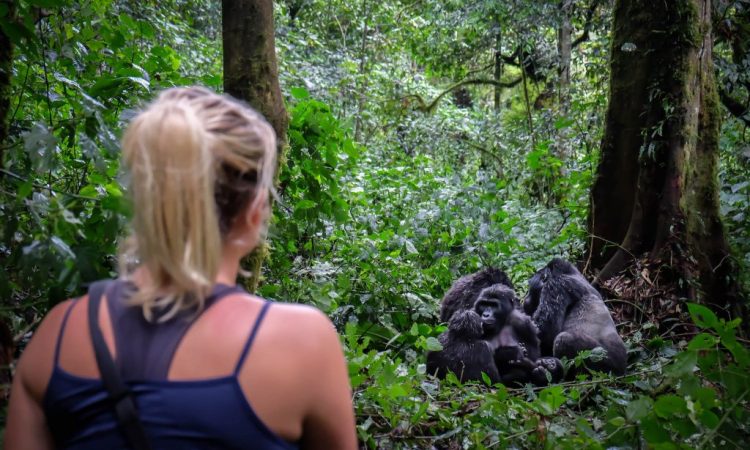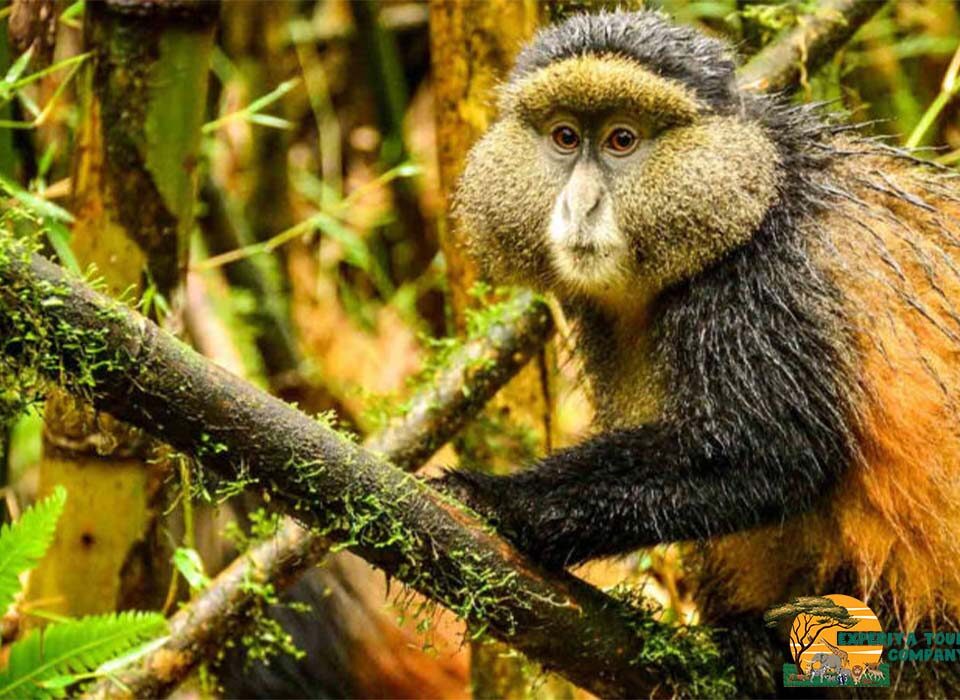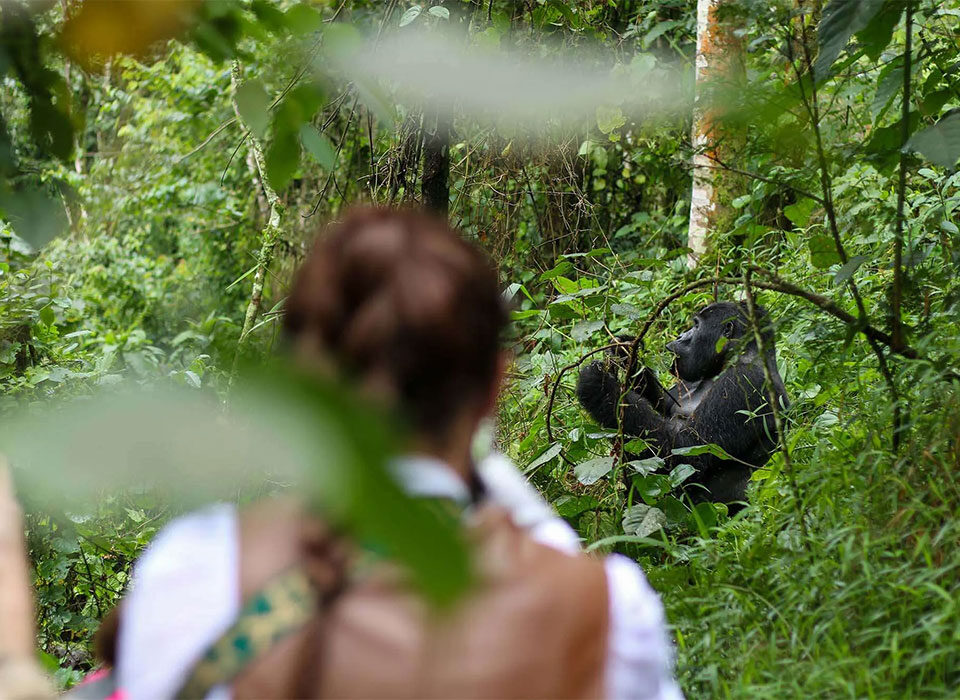
What Are the Different Gorilla Families in Bwindi? | Bwindi Gorilla Groups Explained by Experiya Tour Company
October 22, 2025
Can I Trek Gorillas from Kigali to Bwindi? | Uganda Gorilla Trekking from Rwanda with Experiya Tour Company
October 22, 2025How Do I Choose Between Bwindi and Mgahinga for Gorilla Trekking? | Uganda Gorilla Trekking Guide by Experiya Tour Company

How Do I Choose Between Bwindi and Mgahinga for Gorilla Trekking?
Uganda is one of the few places on Earth where you can come face to face with the majestic mountain gorillas — a species so rare and powerful that every encounter feels like stepping into another world. For many travelers, the hardest part isn’t deciding whether to go gorilla trekking; it’s choosing where to go. Uganda has two main destinations for gorilla trekking: Bwindi Impenetrable National Park and Mgahinga Gorilla National Park. Both parks are breathtaking, both offer unforgettable encounters, yet they differ in terrain, atmosphere, and accessibility. So, how do you choose between them?
This guide will help you understand the key differences between Bwindi and Mgahinga — from trekking experience, gorilla families, accessibility, scenery, and accommodation — to help you decide which one is best for your travel style.
An Overview of Uganda’s Gorilla Parks
Before diving into comparisons, it’s important to understand what makes each park unique.
Bwindi Impenetrable National Park is located in southwestern Uganda and covers about 331 square kilometers of dense tropical rainforest. It’s home to nearly half of the world’s mountain gorilla population, with over 22 habituated families available for trekking. The park’s name, “Impenetrable,” truly captures its character — a misty, ancient forest filled with tangled vines, moss-covered trees, and steep ridges.
Mgahinga Gorilla National Park, on the other hand, is Uganda’s smallest national park, covering about 33.7 square kilometers. It lies within the Virunga Volcanoes region, forming part of a larger transboundary ecosystem shared with Rwanda’s Volcanoes National Park and the Democratic Republic of Congo’s Virunga National Park. Mgahinga is home to one habituated gorilla family, the famous Nyakagezi group, and is known for its striking volcanic scenery and golden monkey encounters.
While both parks guarantee gorilla sightings, the overall experience can feel very different — so your choice will depend on what kind of trek and travel atmosphere you prefer.
1. Gorilla Population and Trekking Experience
The biggest difference between Bwindi and Mgahinga is the number of gorilla families available for trekking.
Bwindi Impenetrable National Park has over 22 habituated gorilla families, spread across four main sectors: Buhoma, Ruhija, Rushaga, and Nkuringo. Each sector has multiple families, meaning there are more daily trekking permits available and greater flexibility when planning.
The trekking experience in Bwindi varies widely. Some families are close to the park entrance, requiring short hikes, while others live deep in the forest, demanding more strenuous treks lasting several hours. The terrain is steep and dense, but that’s part of what makes Bwindi special — it feels wild and untamed. Every trek is unique, as you follow experienced rangers through thick jungle, listening for rustling leaves and gorilla calls before the unforgettable moment you find them.
Mgahinga Gorilla National Park, in contrast, has just one habituated family — the Nyakagezi group. This makes the experience more exclusive, as only eight visitors can trek them each day. The smaller scale means the trek feels intimate and personal. The Nyakagezi group is known for its stability and playful nature, with several strong silverbacks, females, and juveniles. In the past, the group used to cross borders into Rwanda and Congo, but in recent years they’ve settled permanently in Uganda, offering reliable sightings.
In summary, if you want more options and the chance to choose among several families, Bwindi is the better choice. If you prefer a quieter, one-of-a-kind experience with fewer people, Mgahinga is ideal.
2. Terrain and Scenery
The landscapes of Bwindi and Mgahinga are strikingly different, and they dramatically shape your trekking experience.
Bwindi’s Terrain: Bwindi is a dense tropical rainforest — thick, dark, and often misty. The trails twist through towering trees, ferns, and vines. It’s cooler here, and the forest floor is usually damp or muddy. Trekking in Bwindi can be steep, with climbs and descents through valleys and ridges, but it offers that raw “into the wild” feeling. The scenery feels ancient and primal, almost like stepping into a living version of The Jungle Book.
Mgahinga’s Terrain: Mgahinga’s environment is volcanic, with open bamboo forests and rolling hills dominated by three extinct volcanoes — Mount Gahinga (3,474 m), Mount Muhabura (4,127 m), and Mount Sabyinyo (3,669 m). Trekking here is visually spectacular, with panoramic views of the Virunga ranges and sweeping valleys. The terrain is less dense than Bwindi’s, making hiking a bit easier in some areas. You’ll often see golden monkeys, birds, and even traces of forest buffalo.
So, if you prefer lush jungle trekking in an “impenetrable” forest, choose Bwindi. If you’re drawn to dramatic volcanic scenery and open landscapes, Mgahinga will take your breath away.
3. Gorilla Trekking Difficulty
Trekking difficulty is one of the biggest considerations for visitors.
Bwindi is generally considered more challenging because of its steep, slippery trails and thick vegetation. The altitude ranges from 1,160 to 2,600 meters, and some gorilla families move to high elevations, requiring longer treks. However, the rangers assign trekking groups based on your fitness level. Those who prefer shorter, less strenuous hikes can request families that are closer to the starting point.
Mgahinga, although located at higher elevation (2,227 to 4,127 meters), often offers less physically demanding treks. The trails are more open and easier to navigate, especially when gorillas are foraging lower on the slopes. Trekkers with moderate fitness levels often find Mgahinga more comfortable.
If you’re up for a challenging adventure, Bwindi delivers. If you want something more relaxed yet equally rewarding, Mgahinga might be the better fit.

4. Accessibility and Location
Both Bwindi and Mgahinga are in southwestern Uganda, roughly 8–10 hours by road from Kampala or Entebbe. However, accessibility depends on where you’re coming from.
Bwindi has four main entry sectors (Buhoma, Ruhija, Rushaga, Nkuringo), each with different access routes. Buhoma is the easiest to reach from Kampala, while Rushaga and Nkuringo are closer if you’re coming from Kigali, Rwanda — just a 4–5-hour drive across the Cyanika or Katuna border. This makes Bwindi perfect for travelers doing a Uganda-Rwanda combined safari.
Mgahinga is the smaller park, located near the town of Kisoro and very close to the Rwandan border as well. It’s easy to access from Kigali, taking roughly the same 4–5 hours by road. Mgahinga is also located just 14 km from Kisoro town, meaning you can stay in town and easily reach the park headquarters in the morning.
In short, both parks are accessible, but Bwindi offers more accommodation options across its multiple sectors, while Mgahinga is simpler for short, focused treks.
5. Gorilla Permit Availability and Cost
In Uganda, a gorilla trekking permit costs USD 800 per person for foreign non-residents (as of 2025). The price is the same whether you trek in Bwindi or Mgahinga.
However, because Bwindi has many habituated families, there are more permits available daily — roughly 176 compared to just 8 in Mgahinga. This makes it easier to find availability, especially during high season (June to September and December to February). Travelers with flexible dates might enjoy Mgahinga’s exclusivity, while those needing specific dates should book Bwindi early to guarantee a spot.
6. Additional Activities and Wildlife
If you’re planning to extend your trip beyond gorilla trekking, both parks offer great experiences — but in different ways.
In Bwindi, you can combine gorilla trekking with community tours, birdwatching, nature walks, and visits to the Batwa cultural villages. The park is home to over 350 bird species and countless butterflies. You can also combine Bwindi with nearby Queen Elizabeth National Park for a classic savanna safari, just a few hours’ drive away.
In Mgahinga, you can combine gorilla trekking with the unique golden monkey tracking, a fun and colorful experience where you follow endangered golden monkeys through bamboo forests. You can also hike the Virunga Volcanoes — Sabyinyo, Gahinga, or Muhabura — for spectacular views into Rwanda and Congo. The Batwa Cultural Trail in Mgahinga offers a deeper cultural immersion into the lives of the region’s indigenous forest people.
So, if you want more add-on safari activities, Bwindi wins. If you’re after volcano hiking and golden monkey tracking, Mgahinga is unbeatable.
7. Accommodation and Lodging Options
Bwindi offers a vast range of lodges — from ultra-luxury retreats like Clouds Mountain Gorilla Lodge and Bwindi Lodge to comfortable mid-range and budget-friendly options. Every sector has quality accommodation, and many lodges boast forest views or even gorilla visits to their gardens.
Mgahinga has fewer options, but the ones available are cozy and scenic. Lodges like Mount Gahinga Lodge and Mutanda Lake Resort provide beautiful views of the volcanoes and nearby lakes. For travelers seeking exclusivity and quiet surroundings, Mgahinga is perfect.
Which Park Should You Choose?
If you’re looking for variety, more gorilla families, multiple trekking zones, and a mix of luxury and adventure, then Bwindi Impenetrable National Park is the ideal choice. It’s great for both first-timers and repeat visitors who want to experience Uganda’s signature gorilla trekking destination.
If you prefer fewer crowds, breathtaking volcanic scenery, golden monkeys, and a quieter experience, then Mgahinga Gorilla National Park is your best choice. It’s perfect for travelers who love off-the-beaten-path destinations and more relaxed treks.
Ultimately, both parks deliver the same priceless reward — the chance to stand meters away from a mountain gorilla family in their natural home. Whichever you choose, you’ll walk away transformed.
Plan Your Gorilla Trekking Adventure with Experiya Tour Company
Whether you decide on Bwindi or Mgahinga, the secret to an unforgettable gorilla trekking experience lies in traveling with a trusted and experienced safari operator — and Experiya Tour Company is one of Uganda’s finest.
Experiya Tour Company specializes in tailor-made gorilla trekking safaris across Uganda and East Africa. Their expert team will handle everything from securing your permits and booking lodges to organizing seamless transport and professional guides who know the parks inside out. They’ll help you choose the best trekking sector based on your interests, fitness level, and schedule — ensuring you get the most out of your gorilla encounter.
Whether it’s the dense mystery of Bwindi or the volcanic beauty of Mgahinga, Experiya ensures your journey is smooth, safe, and deeply enriching. Traveling with Experiya means you’re not just visiting Uganda; you’re supporting sustainable tourism and local conservation efforts that protect these endangered giants for generations to come.
For a once-in-a-lifetime gorilla trekking experience — crafted perfectly to your needs — book your safari with Experiya Tour Company and let Uganda’s wild heart leave you forever changed.



